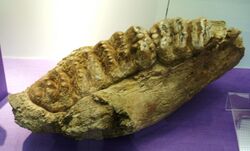Biology:Stegolophodon
| Stegolophodon Temporal range: Early-Late Miocene
| |
|---|---|

| |
| Tooth of Stegolophodon latidens | |
| Scientific classification | |
| Domain: | Eukaryota |
| Kingdom: | Animalia |
| Phylum: | Chordata |
| Class: | Mammalia |
| Order: | Proboscidea |
| Family: | †Stegodontidae |
| Genus: | †Stegolophodon Schlesinger, 1917 |
| Type species | |
| †Stegolophodon latidens (Clift, 1828)
(originally Mastodon latidens) | |
| Species | |
| |
Stegolophodon is an extinct genus of stegodontid proboscideans. It lived during the Miocene epoch in Asia.[1][2][3][4][5] The earliest fossils are known from the Early Miocene, with one of the oldest fossils being from Japan, estimated to be 17.3 million years old. It is suggested to be the ancestor of Stegodon, and transitional fossils between the two genera known from the Late Miocene of Southeast Asia and Yunnan in South China. Like modern elephants, Stegolophodon developed proal jaw movement, where the lower jaw moves in a back-to-front motion, rather than the oblique chewing motion used by earlier proboscideans, with this development already present by 17.3 million years ago.[6] Members of the genus generally have tetralophodont molars, and retain tusks on the lower jaw. The upper tusks have an enamel band.[7]
References
- ↑ Suga, Shoichi; Nakahara, Hiroshi (2012-12-06) (in en). Mechanisms and Phylogeny of Mineralization in Biological Systems: Biomineralization '90. Springer Science & Business Media. ISBN 9784431681328. https://books.google.com/books?id=U47nCAAAQBAJ.
- ↑ Youping Zhang, Yuzhu Long, Hongxiang Ji, Suyin Ding, Translated by Will Downs Bilby Research Center, Northern Arizona University March (November 1999). "The Cenozoic Deposits of the Yunnnan Region". Professional Papers on Stratigraphy and Paleontology No. 7, Geological Publishing House, Peking, China, Pp. 1-21. http://paleoglot.org/files/Zhang&_83.pdf.
- ↑ Geer, Alexandra van der; Lyras, George; Vos, John de; Dermitzakis, Michael (2011-02-14) (in en). Evolution of Island Mammals: Adaptation and Extinction of Placental Mammals on Islands. John Wiley & Sons. ISBN 9781444391282. https://books.google.com/books?id=JmSsNuwMAxgC.
- ↑ "The first mariners | AURANET". http://www.ifrao.com/the-first-mariners/.
- ↑ "Fossilworks: Stegolophodon". http://www.fossilworks.org/cgi-bin/bridge.pl?a=taxonInfo&taxon_no=43272.
- ↑ Saegusa, Haruo (March 2020). "Stegodontidae and Anancus: Keys to understanding dental evolution in Elephantidae" (in en). Quaternary Science Reviews 231: 106176. doi:10.1016/j.quascirev.2020.106176. Bibcode: 2020QSRv..23106176S. https://linkinghub.elsevier.com/retrieve/pii/S0277379119302665.
- ↑ Iizumi, Katsunori; Ando, Hisao; Suzuki, Kunihiro; Koda, Yoshiki (2021-07-01). "Mandibular Morphology of Stegolophodon pseudolatidens (Proboscidea, Stegodontidae) from the Lower Miocene of Japan". Paleontological Research 25 (3). doi:10.2517/2020PR025. ISSN 1342-8144. https://bioone.org/journals/paleontological-research/volume-25/issue-3/2020PR025/Mandibular-Morphology-of-Stegolophodon-pseudolatidens-Proboscidea-Stegodontidae-from-the-Lower/10.2517/2020PR025.full.
Wikidata ☰ Q3021923 entry
 |


